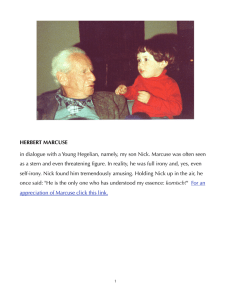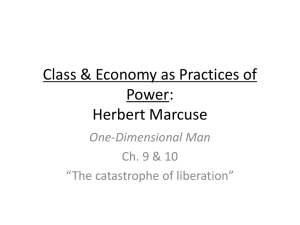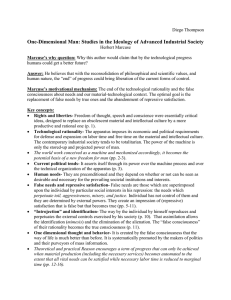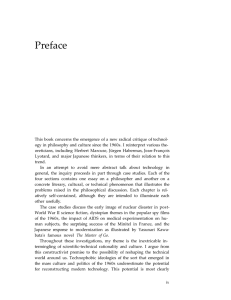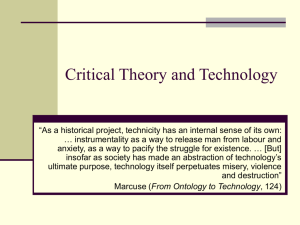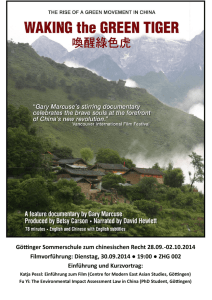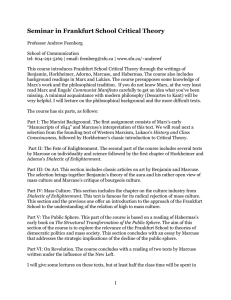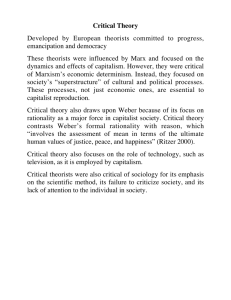Marcuse on Art and Technology
advertisement
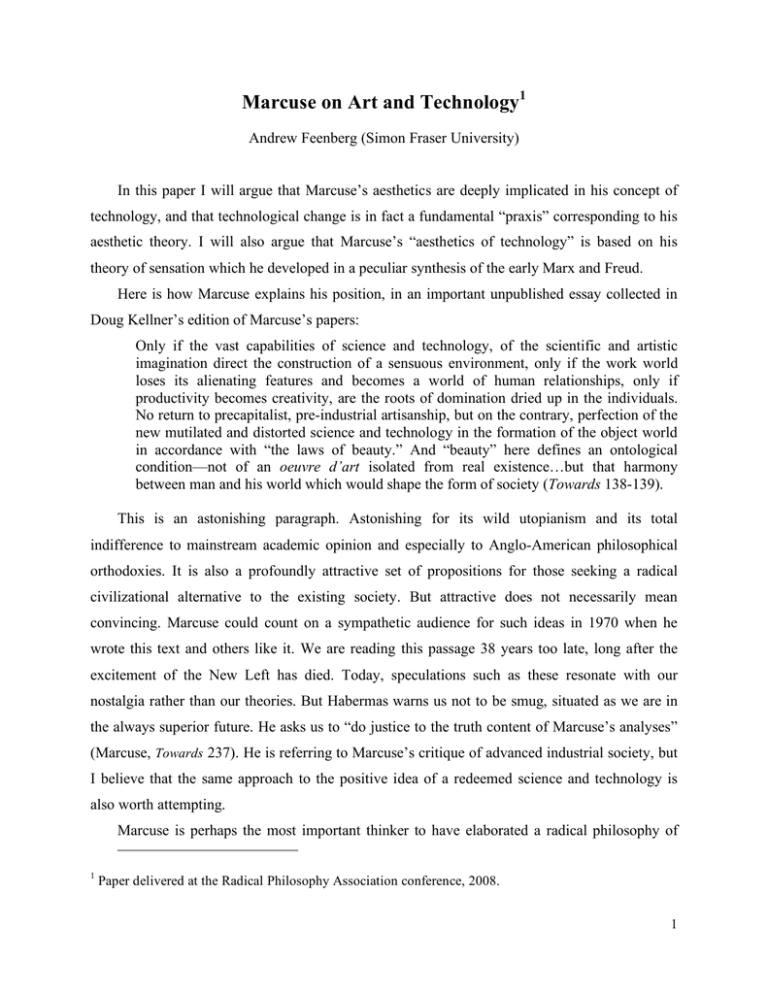
Marcuse on Art and Technology1 Andrew Feenberg (Simon Fraser University) In this paper I will argue that Marcuse’s aesthetics are deeply implicated in his concept of technology, and that technological change is in fact a fundamental “praxis” corresponding to his aesthetic theory. I will also argue that Marcuse’s “aesthetics of technology” is based on his theory of sensation which he developed in a peculiar synthesis of the early Marx and Freud. Here is how Marcuse explains his position, in an important unpublished essay collected in Doug Kellner’s edition of Marcuse’s papers: Only if the vast capabilities of science and technology, of the scientific and artistic imagination direct the construction of a sensuous environment, only if the work world loses its alienating features and becomes a world of human relationships, only if productivity becomes creativity, are the roots of domination dried up in the individuals. No return to precapitalist, pre-industrial artisanship, but on the contrary, perfection of the new mutilated and distorted science and technology in the formation of the object world in accordance with “the laws of beauty.” And “beauty” here defines an ontological condition—not of an oeuvre d’art isolated from real existence…but that harmony between man and his world which would shape the form of society (Towards 138-139). This is an astonishing paragraph. Astonishing for its wild utopianism and its total indifference to mainstream academic opinion and especially to Anglo-American philosophical orthodoxies. It is also a profoundly attractive set of propositions for those seeking a radical civilizational alternative to the existing society. But attractive does not necessarily mean convincing. Marcuse could count on a sympathetic audience for such ideas in 1970 when he wrote this text and others like it. We are reading this passage 38 years too late, long after the excitement of the New Left has died. Today, speculations such as these resonate with our nostalgia rather than our theories. But Habermas warns us not to be smug, situated as we are in the always superior future. He asks us to “do justice to the truth content of Marcuse’s analyses” (Marcuse, Towards 237). He is referring to Marcuse’s critique of advanced industrial society, but I believe that the same approach to the positive idea of a redeemed science and technology is also worth attempting. Marcuse is perhaps the most important thinker to have elaborated a radical philosophy of 1 Paper delivered at the Radical Philosophy Association conference, 2008. 1 technology. One can dismiss his writings as bound to a historical context that no longer exists or one can attempt to understand his ideas sympathetically in a contemporary context. This latter choice requires some fairly drastic revisions but seems to me worth attempting. But it is not an easy task to interpret Marcuse’s views in a way that communicates directly with us today. As Habermas notes, Marcuse presents the “truth content” of his analyses in “concepts that have become foreign to us” (Marcuse, Towards 237). I will try here to reformulate some of his insights in a language more accessible to us. Let me begin by simply elucidating the meaning of the text I have cited on its own terms. The concept of the “aesthetic” is ambiguous, as Marcuse points out, “pertaining to the senses and pertaining to art” (Towards 132). This ambiguity is not merely semantic but stems from a common structure. The two meanings are united in the imposition of what Marcuse calls “form” on a material of some sort. The senses are engaged in a practice just as is art and with potentially similar results. In order to show this, Marcuse introduces an unusual theory of sensation based on his quasi-phenomenological interpretation of Marx’s 1844 Manuscripts. Marx claims that the senses have a history determined by social and economic development. The real content of experience is gradually revealed as civilization advances. There is a hierarchy of sensation, going from a minimal, crude encounter with the object through the full realization of its complexity and beauty. A dog may hear a symphony but it will not hear what its master hears. The human being at home in the world under socialism will find more in nature than the impoverished and alienated worker under capitalism. The aesthetic in both senses of the term is invoked here. Like the practice of art-making, the “practice” of sensation involves on the one hand objects rich in meaning and on the other subjects capable of receiving that meaning. This reception is not passive but involves granting form to the given. Marx corrects in this way the over-emphasis on the object in empiricism and the subject in Kantian idealism. His theory corresponds to what Adorno refers to as a “mediation” theory of sensation in which both object and subject contribute to the shaping of experience. The unusual feature of Marcuse’s Marx interpretation is the emphasis he places on Marx’s surprising notion that while the animals appropriate nature only to satisfy their needs, “man constructs also in accordance with the laws of beauty” (Marx 128). Marcuse develops Marx’s 2 brief mention of beauty as an objective characteristic of the real—it has “laws”— in terms of a quasi-Freudian theory of the erotic. He argues that the erotic impulse is directed toward the preservation and furtherance of life. It is not merely an instinct or drive but operates in the sensuous encounter with the world that reveals it in its beauty, the objective correlate of the erotic. But this impulse is repressed by society, partially sublimated, partially confined to sexuality. The loss of immediate sensory access to the beautiful gives rise to art as a specialized enclave in which we perceive the trace of erotic life affirmation. According to Marcuse, aesthetic form is a kind of simplification and idealization that reveals sensuously the true essences of things, things as they would be redeemed in a better world. Form is active in sensation as well. In sense experience it gives rise not only to appreciation of beauty in the world but also to a critical repulsion toward all that is life-destroying and ugly. Marcuse argued that the New Left and the counter-culture gave us a hint of what such a transformed sensorium would be like. These reflections on the senses provide the link between Marcuse’s theories of art and technology. Technology is a product of reason and so distinct from art with its erotic inspiration. But Marcuse claims that modern value-neutral technological rationality is a distortion of an original life-affirming reason. Reason arose to protect and further life and lost that function in modern times only by being stripped back to a bare remnant of itself. This is Marcuse’s account of what he calls the “new mutilated and distorted science and technology” in the passage I cited earlier. The notion of rational life affirmation requires imaginative input of some sort. In the past reason aimed at discursive comprehension of the ideal form of its objects, their essence, that is, the objects’ unfolded and fulfilled potentialities. The imagination is involved in the transcendence of the empirically given toward the essential. Thus art and reason are not entirely alien to each other since both involve the imagination and both reveal essences, each in its own way. But they have been separated by the pressures of life in class society. While art has been confined to a marginal realm of “affirmative culture,” reason has been reduced to an instrument in the struggle against scarcity. The elements are now in place for a radical revision of the concept of technology. Marcuse projects a possible future in which the life-affirming telos of art and reason would come together under the aegis of an eroticized sensuousness. The result would be a transformation of 3 technology and therefore of the life environment, which is increasingly mediated by technology. Different human beings would inhabit this world with different perceptions and concerns. This would be a socialism that changed not merely some superficial political and economic formations but the structures of reason, art, technology and experience itself. To sum up, the existing society, its art, technology, reason and even the experience of the world it makes possible, are all deviations from original forms that were richer and more unified. Art and technology once merged in practices directed toward the realization of the highest forms of their objects, essences, beauty. Experience and reason were once informed by imagination and sensitive to the erotic impulse which joined them in the appreciation of the essential in things. These original forms can be revived under the new conditions of modernity by a socialist revolution. This summary should make clear what Habermas meant when he claimed that Marcuse’s “concepts…have become foreign to us.” We find it difficult to accept an argument based on a notion of origins such as this one. The Freudian reference is also less convincing today than it used to be. Furthermore, in Freud the erotic is a subjective drive rooted in human physiology, whereas in Marcuse it uncovers objective structures of being. Marcuse’s teleological notion of reason also presupposes this transformation of anthropological categories into ontological categories. Life affirmation is ontologically significant and not simply an instinctual drive. Thus a reason that incorporates the affirmation of life in its structure is in harmony with the nature of things in a way that value-neutral reason is not. For any of these ideas to make sense, the concept of essence must be reconstructed and revived. The empirical form of human beings and things cannot be the last word on their nature. They are haunted by a negativity that refers us to their potentialities. The erotic, the imagination, the affirmation of life are all implicated in the essential that transcends the given. We have reached a stage in history when the gap between existence and essence can be closed by a new technology responsive to values. Strange as all this sounds, its elements taken one by one are not entirely alien to phenomenological trends that still represent an influential alternative to naturalism and Kantianism. The key missing element in Marcuse’s presentation of these ideas is the phenomenological notion of “lifeworld.” Although he mentions something he calls an “aesthetic 4 Lebenswelt” on several occasions, he never elaborates its phenomenological background (Essay 31). Why this is so I have tried to explain in my book Heidegger and Marcuse: The Catastrophe and Redemption of History. But for now, let us see how the introduction of a phenomenological perspective is helpful in reconstructing Marcuse’s redemptive vision. The key problem is the ontological status of lived experience. The nature of natural science is totally disenchanted. It has no room for teleology, for the erotic, for any preference for life over death. Like Melville’s white whale, it is bleached of value and so invites subjective projections of every sort in the form of ever more powerful technologies serving ever more violent ends. Against this background, lived experience is increasingly devalued in modern times. It appears to be thoroughly “refuted,” useful for everyday activity but without epistemic credentials or ontological significance. Marcuse rejects the privilege of nature in this scientific sense in favour of lived experience. Experience is not a subjective overlay on the nature of natural science. It reveals dimensions of reality that science cannot apprehend in its present form. These dimensions, beauty, potentialities, essences, life as a value, are just as real as electrons and tectonic plates. The imagination which projects these dimensions is thus not a merely subjective faculty but reveals aspects of the real. But there is an ambiguity in Marcuse's approach which shows up particularly in his rather vague demand for a new science that would discover value in the very structure of its objects. Does he wish to re-enchant nature, to attribute objective qualities to it that are unrecognized by science? This is the most contentious interpretation of Marcuse’s thought, one which most of us find difficult to accept. But there is an alternative interpretation which also finds support in Marcuse’s writings. According to this alternative, experience is revalorized not in opposition to science but as an alternative ontological field which co-exists with science and claims its own rights and significance. This seems to be the implication of Marcuse’s rejection of any return to a “qualitative physics” (One-Dimensional 166). On this account science as we know it would evolve under the influence of a new socialist environment as would experience in its sphere: quantity and quality in parallel. The philosophical task Marcuse did not, unfortunately, undertake would be to delimit the spheres so as to avoid conflict since neither science nor experience possesses the whole truth. 5 This alternative corresponds to the phenomenological approach as it is explained in thinkers such as Gadamer and Merleau-Ponty. They do not endorse a regressive re-enchantment of nature but defend the multiplicity of points of view on reality. This operation requires a critique of the “view from nowhere” in order to validate the specifically engaged perceptions of a finite being in the world, an embodied being that belongs to a community. Interpreted in this way, it makes sense to claim that the perceived potentialities of objects have a kind of reality. There are important domains of experience to which we bring a normative awareness quite apart from opinions and intellectual constructions. When we encounter a beautiful landscape we perceive its beauty as contrasted with that which is banal or ugly in our environment. A sick person appears to our perceptions to fall short of the norm of health to which we expect conformity. The examples could be multiplied indefinitely. They show that the lived experience of the real is not confined to the empirically given but frequently refers beyond it to essential potentialities it more or less fulfils. This “two-dimensional” nature of experience could be extended to form the basis of the political discrimination Marcuse substitutes for the traditional Marxist notion of class consciousness. Phenomenologically considered, the erotic, which is the basis for the two-dimensional perception of the world, can be understood in terms of Heidegger’s concepts of “attunement” or “state-of-mind.” These concepts refer to the fact that sensory experience is always colored by a general quality of perception such as fear or anxiety, joy or hope. These qualities reveal the world in its various aspects. The Freudian erotic appears to do the same work in Marcuse’s ontological argument. But unlike the Heideggerian equivalents, it reveals the negativity of the world against a normative background. This phenomenological interpretation of Marcuse also makes sense of his attempt to unite art and technology in a new concept of technological rationality that would be intrinsically valueoriented. This contribution could be developed independently of the hope in a new science which appears to commit Marcuse to a re-enchantment of nature he does not need to support his political argument. In this restricted version of his thesis we would find Marcuse claiming that technical disciplines can be restructured under the aegis of values such as beauty that are revealed in experience. The arts would appear not as antagonistic to technology but rather as informing it through sensitizing people to the potentialities of their objects. Something like Schiller’s “aesthetic education” would be at work here, but it would not be confined to character, 6 as it is in Schiller, but would extend to the technological environment in which and through which the individuals live. Can we make sense in contemporary terms of this vision of an aestheticized technology? Surprisingly, the answer to this question is “Yes,” subject to those drastic revisions I mentioned above. In fact we are better able to understand and develop this idea today than we were in Marcuse’s day. This is because the traditional notion of technology as a pure rational “means” to subjective “ends” has been decisively refuted by philosophy and sociology of technology in recent years. We no longer believe that technology is value-neutral. Rather, contemporary technology studies argue that technological design always incorporates values through the choices made between the many possible alternatives confronting the designers. Technologies are not mere means but shape an environment in terms of an implicit conception of human life. They are inherently political. But if this is so, Marcuse’s argument gains in plausibility. Marcuse claimed that the problem with modern technology stemmed from its value neutrality. Although he did not develop a proper historical account, he appears to have believed that premodern technology was guided by values incorporated into the standards and practices of craft, values that reflected a wide range of human needs. The stripping away of these constraints on modern technology turns it from an instrument in the service of life into an instrument of domination by the powerful. The task then is to recover a relationship between technology and values. This critique of value neutrality is not entirely compatible with contemporary views as it stands but it can be reformulated in a way that preserves Marcuse’s essential point. Consider value neutrality not as an achieved state of purity but as a tendency with a history. Indeed, the development of modern technology is accompanied by the gradual stripping away of traditional restraints on technical practice. The imperatives of the capitalist market underlie this tendency to free technology from craft values to a development oriented exclusively toward profit. Naturally, the pursuit of profit mediates real demands which continue to shape technical designs. No complete value neutrality is ever achieved, but the tendency is toward a simplification of the valuative constraints on design. The less technology is invested with pre-established values, the more easily it can be adapted to the changing conditions of the market. Hence the appearance of value neutrality of modern production, with its purified technical disciplines to which correspond 7 standardized parts available for combination in many different patterns with different value implications. Reformulated on these terms, Marcuse’s argument suggests a quite definite future for technology under socialism. Technical disciplines and technologies would be constrained by values related not just to profitability but more broadly to human and natural needs recognized in political debate. The emergence of these new constraints should not be conceived as obstacles but as opportunities. The capacity for innovation would be challenged by these political demands much as it is challenged today by market demands. The situation Marcuse foresaw is anticipated by the regulation of technology where it imposes life-affirming standards independent of the market. This is already the case in relation to environmental and medical standards to an ever increasing degree. Socialism would represent a shift in the balance toward far more extensive regulation based on far more democratic procedures. I want to conclude by arguing that Marcuse’s theory offers a powerful basis for a radical philosophy of technology. While political and social philosophy continue to abstract from technology altogether, neither phenomenological nor sociological studies of technology have succeeded in getting us there. Contemporary Heideggerian critiques of technology do not really address technology itself but only modern attitudes toward it. Don Ihde’s phenomenological philosophy of technology goes much further, but he simply ignores the normative elements in lived experience and so offers an apolitical perspective on the highly political question concerning technology. Science and technology studies for the most part have avoided politics and taken what Wiebe Bijker calls the “academic detour.” But in the age of nuclear proliferation, global warming and the globalization of disease, it is difficult to see how this attitude can be maintained. Marcuse opens the door to a political philosophy of technology closed by most contemporary approaches. It is time we passed through that door, each in our own way of course, to develop an argument with our times. 8 Bibliography Feenberg, Andrew. Heidegger and Marcuse: The Catastrophe and Redemption of History. London: Routledge, 2005. Marcuse, Herbert. One-Dimensional Man. Boston: Beacon Press, 1964. Marcuse, Herbert. An Essay on Liberation. Boston: Beacon, 1969. Marcuse, Herbert. Towards a Critical Theory of Society, D. Kellner, ed. New York: Routledge, 2001. Marx, Karl. Karl Marx: Early Writings, T. Bottomore, ed. London: C.A. Watts, 1963. 9 Feenberg, Andrew. “Marcuse on Art and Technology.” Forum: Postgraduate Journal - Issue 8: Technologies, Spring 2009.
